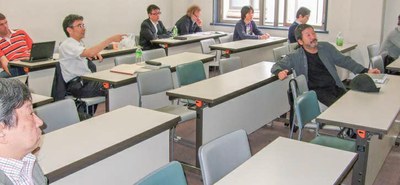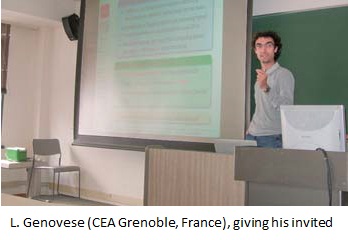Tokyo Satellite Workshop
CMSI Tokyo Satellite Workshop 2013
Novel Electronic Structure Calculation Method
Implementing a new method for calculating electron states
 This satellite workshop was held over two days, October 18 and 19, 2013, at the Faculty of Engineering Building 6 on The University of Tokyo Hongo Campus. The gaussian base method is widely used, particularly in the field of quantum chemistry, as a way of implementing non-empirical electron state calculation methods, while the plane wave base method is widely used in the field of solid state physics. In addition to these two mainstream methods, new methods such as the real-space finite difference method, the finite element method and the wavelet base method have been used increasingly in recent years to implement electron state cal ulations. One reason for this is the need to accommodate the massively parallel use of computers. For example, unavoidably fast Fourier transformation is needed for the band calculation codes for solids that use the plane wave base method, and there have been concerns regarding whether this can be accommodated by massively parallel computers. Moreover, gaussian functions and the plane wave base method are tightly constrained by the boundary conditions for the calculations, and this was a major restriction when modeling surfaces, interfaces and even more complex materials.This satellite workshop featured presentations on the real-space finite difference method, the finite element method and the wavelet base method by six researchers from Japan and three researchers from overseas. The goal was to discuss the characteristics of each method and deepen understanding, and with any luck to appropriate technologies that can be used in each code. The presentations on the real-space finite difference method were given by myself, Tomoya Ono, Masashi Noda and Shunsuke Sato from Japan, and by Jussi Enkovaara, one of the developers of the GPAW package, from overseas. The presentations on the finite element method were given by Eiji Tsuchida from Japan and Volker Schauer from overseas. The presentations on the wavelet base method were given by Hideo Sekino from Japan and Luigi Genovese, one of the developers of BigDFT, from overseas. The workshop made clear that each of these methods has elements that overcome the aforementioned problems, and moreover that they all possessed adaptivity, something that previous methods did not offer.
This satellite workshop was held over two days, October 18 and 19, 2013, at the Faculty of Engineering Building 6 on The University of Tokyo Hongo Campus. The gaussian base method is widely used, particularly in the field of quantum chemistry, as a way of implementing non-empirical electron state calculation methods, while the plane wave base method is widely used in the field of solid state physics. In addition to these two mainstream methods, new methods such as the real-space finite difference method, the finite element method and the wavelet base method have been used increasingly in recent years to implement electron state cal ulations. One reason for this is the need to accommodate the massively parallel use of computers. For example, unavoidably fast Fourier transformation is needed for the band calculation codes for solids that use the plane wave base method, and there have been concerns regarding whether this can be accommodated by massively parallel computers. Moreover, gaussian functions and the plane wave base method are tightly constrained by the boundary conditions for the calculations, and this was a major restriction when modeling surfaces, interfaces and even more complex materials.This satellite workshop featured presentations on the real-space finite difference method, the finite element method and the wavelet base method by six researchers from Japan and three researchers from overseas. The goal was to discuss the characteristics of each method and deepen understanding, and with any luck to appropriate technologies that can be used in each code. The presentations on the real-space finite difference method were given by myself, Tomoya Ono, Masashi Noda and Shunsuke Sato from Japan, and by Jussi Enkovaara, one of the developers of the GPAW package, from overseas. The presentations on the finite element method were given by Eiji Tsuchida from Japan and Volker Schauer from overseas. The presentations on the wavelet base method were given by Hideo Sekino from Japan and Luigi Genovese, one of the developers of BigDFT, from overseas. The workshop made clear that each of these methods has elements that overcome the aforementioned problems, and moreover that they all possessed adaptivity, something that previous methods did not offer.
The path to all-electron calculation
Adaptivity is a technique in which calculation points can be concentrated in locations with dramatic changes in functions, for example near the atomic nucleus, while calculation points are only sparsely distributed in areas that experience more gradual change. Promoting the use of this technique makes it easy to handle things extending to the electrons in the core,  in other words enabling “all-electron calculation.” The concrete implementation of this technique is being promoted in the finite element method and the wavelet base method. It is known that gaussian functions do not form a complete system in mathematical terms, and the base functions tend to become linearly dependent on one another, so it is difficult to increase the precision of the system. The presentation by Sekino, in which he said that“wavelets may become a new base function for quantum chemistry calculations that form a complete system,” was impressive.
in other words enabling “all-electron calculation.” The concrete implementation of this technique is being promoted in the finite element method and the wavelet base method. It is known that gaussian functions do not form a complete system in mathematical terms, and the base functions tend to become linearly dependent on one another, so it is difficult to increase the precision of the system. The presentation by Sekino, in which he said that“wavelets may become a new base function for quantum chemistry calculations that form a complete system,” was impressive.
The current mainstream methods ̶ gaussian functions and the plane wave base method ̶ were developed at a time when computers themselves were in the process of being born and maturing. Compared to that time, modern computers have been completely transformed. Algorithms that were developed in the early stages are becoming incompatible with the most recent computer architectures. Even so, it is not possible for us to switch over to other methods immediately. Even the simple implementation of a new technique requires enormous amounts of time and labor. It has been said that the introduction of Python succeeded in reducing the development time for GPAW and other packages. But undoubtedly there are some people who are reluctant to spend the time needed to become familiar with the use of Python. As computers evolve to have greater and greater complexity, the costs of program development will increase greatly as well, and this is a frequent topic of debate inefforts to achieve exabyte computing. This satellite workshop served to make us consider this issue once again. To be honest, however, the answer to the question of what should ultimately be done about it has not yet been discovered.
(Jun-ichi Iwata: Graduate School of Engineering,The University of Tokyo )

